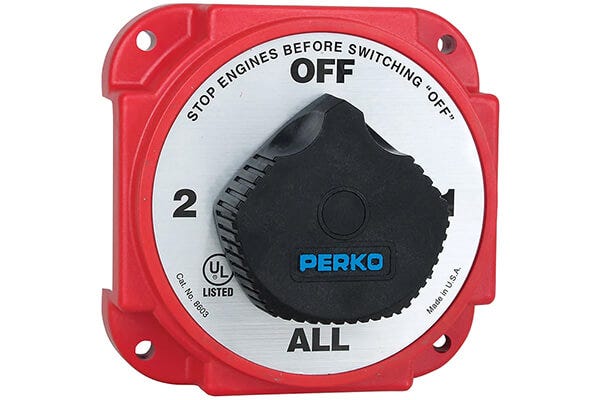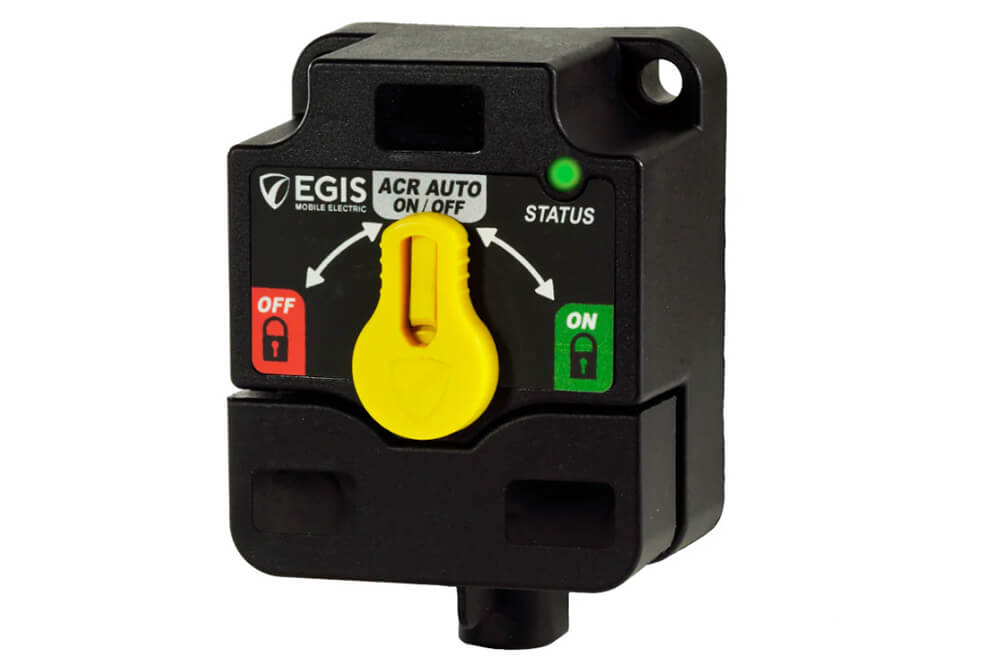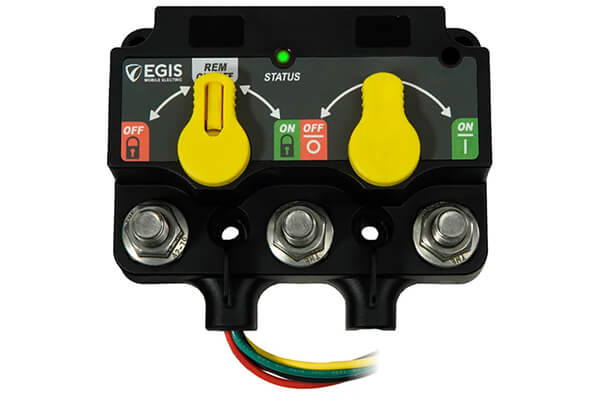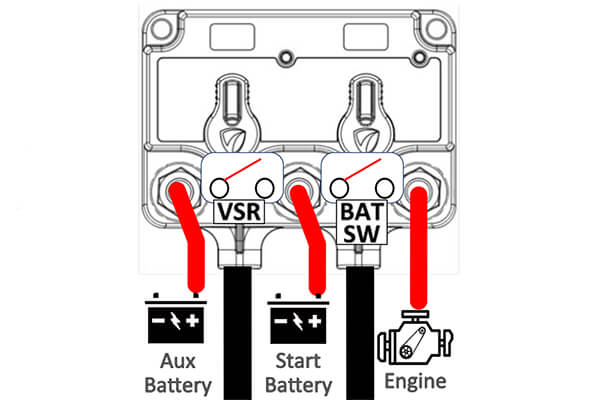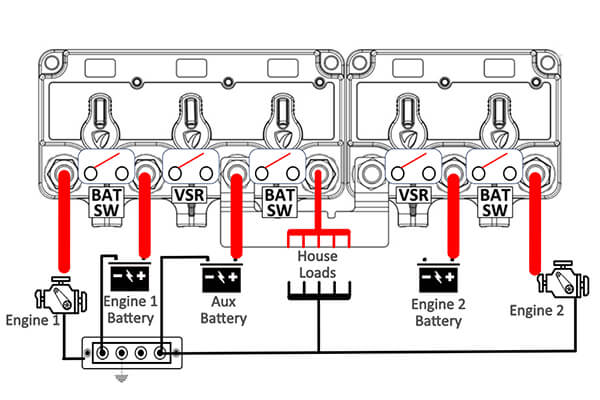

At first glance, the innovative XD Series of high-amp remote relays made by Egis Mobile Electric can be confusing. At second glance, they get even more confusing — at least for the average boat owner. But it’s worthwhile to take a few minutes to understand these electrical components, since they represent a meaningful advance in marine battery management.
In fact, the system won a prestigious Innovation Award at IBEX (the International Boatbuilders’ Exhibition and Conference) in 2022. Here’s what you need to know.
Contents
If Relays Are the Solution, What’s the Problem?
To keep things as simple as possible, let’s consider a boat with a single outboard, a single starting battery, and a single “house” battery.
At the center of a system like that is usually an OFF-1-2-BOTH battery switch.
In most cases, it’s the familiar “big red knob.”
With the knob in the 1 position, the starting battery is connected to the boat’s electrical system, and the house battery is isolated from all loads (except probably a float switch and bilge pump wired straight to the battery). With the knob in the 2 position, the house battery is connected to the electrical system, and the starting battery is isolated from all loads. With the knob in the OFF position, both batteries are isolated from all loads and from each other. And with the knob in the BOTH position — you guessed it! — both batteries are connected to the boat’s electrical system and to each other.
In the real world, most boaters either turn the battery switch to BOTH when they launch and to OFF when they get home.
Here’s how that system is supposed to work. When you launch your boat in the morning, you turn the knob from OFF to 1 and start the engine. This protects the house battery from the load of starting the engine. Before you get underway, you turn the knob to BOTH. This allows the current from the engine’s alternator to charge both of your batteries simultaneously. When you get to your first fishing spot and shut off the outboard but leave on your fishfinder, livewell pump and stereo, you switch the knob to 2. This isolates the starting battery from these loads and uses the house battery to run them. When it’s time to start the outboard again, you turn the knob back to 1.
Which all sounds great in theory, except that virtually nobody actually does it. In the real world, most boaters either turn the battery switch to BOTH when they launch and to OFF when they get home, or they turn it to either 1 or 2 and leave it there all day in order to keep one battery in reserve. Both will work just fine almost all the time. But both more or less negate the advantages of having a switched two-battery system in the first place.
How Automatic Relays Work
Voltage sensing relays — commonly known to boaters as ACRs (which stands for automatic charging relay or automatic combining relay, depending on who you ask) — essentially automate the job of switching between 1, 2 and BOTH.
When your engine is running and the alternator is putting out current, the ACR senses the charging voltage and automatically connects both the house and starting batteries so that both charge. When the engine is off and a load is present — a stereo, for example — the ACR automatically isolates the batteries from each other, protecting the starting battery.
What’s Different about the Egis XD Series
Typically, ACRs have been combined with one or more manual battery switches (big red knobs), depending on the number of engines and battery banks. That requires a fair amount of real estate for mounting. Additionally, the cables that connect the switch and relay add cost and potential failure points. And you still have to turn your big red knobs at least once a day, which can be a pain if they aren’t easily accessible.
Egis XD modules combine the functions of battery switches and ACRs into a single compact, durable module and offer remote switching capabilities — meaning a rocker switch or push button right on your dash can do the same thing as the big red knob.
Egis XD modules combine the functions of battery switches and ACRs into a single compact, durable module.
Understanding Egis XD Series Functions
Part of what makes the XD relays appear complicated is their flexibility. They can actually be configured by the user or installer for a variety of functions. But once you understand the basic structure, the system starts to make sense.
First, XD relays are available in single, dual and triple configurations. The dual and triple devices are simply two or three individual relays, respectively, in the same “box” or module. If your configuration requires more than three relays, you can combine modules like building blocks to create the system you need. Each individual relay is composed of a switch connecting two terminals.
Second, each individual relay can be configured by the installer to function as either a simple ON-OFF battery switch or as an ACR that opens or closes based on voltage to isolate batteries when a load is present and combine them when a charge is present. Keep in mind that every XD module comes pre-configured in a certain way.
Example Configuration: One Engine with Two Batteries
For the same kind of electrical system described above — a single outboard with one starting battery and one house battery — you would use an XD Triple Flex 2 Relay/ACR/Relay module. This particular configuration consists of three adjacent relays. The center relay is configured to function as an ACR, while the two outer relays are configured to function as remotely operated battery switches.
This setup is basically the equivalent of an individual ON-OFF big red knob for each battery plus an ACR that automatically isolates the batteries from each other when a load is present or combines them when a charge is present. But it differs in several ways:
- The overall footprint is considerably smaller than two separate switches plus an ACR. The amount of cable and number of connections required is also less.
- Both of the ON-OFF battery switches can be operated remotely from the dash via a standard rocker or push-button switch. Turning these to the OFF position isolates the batteries from all loads.
- The ACR can also be remotely operated, overriding its automatic functions. That means you can briefly combine both batteries with a switch on your console for emergency starting. You can also manually isolate them from each other if needed.
- The threshold voltages for automatically combining and isolating the batteries are adjustable.
- Each individual relay outputs a signal for an LED indicator light. Installed on the dash, the LEDs indicate the status of your electrical system at a glance.
- The standby current draw, 1.3mA per relay, is exceptionally low.
Egis XD Options
Beyond how many individual relays you need and what function you want each to serve, there are a few more options to be aware of.
Manual Override Knobs
All Egis XD modules are available with or without a yellow physical override knob on the front of each individual relay. All of the modules carried by Boat Outfitters feature these override knobs. The knobs allow you to manually control the relays directly from the front of the module. Battery switches can be turned ON or OFF or set for remote control via a switch. ACRs can be locked ON (combined) or OFF (isolated) or set to automatic.
Override knobs allow you to manually control the relays directly from the front of the module.
Mechanical Only Switches
Modules are also available with mechanical switches instead of remotely controlled switches. These are essentially the same thing as a big red knob type switch — just smaller. As described above, even switches with remote control capability can be manually switched directly on the module. But mechanical-only switches have no remote options.
The XD Triple Flex 2 Mechanical Switch/ACR/Mechanical Switch, for example, does the same job as the XD Triple Flex 2 Relay/ACR/Relay described above except that the battery ON-OFF switches can’t be operated from the dash.
Control Wiring
Each individual relay has control wiring for remote operation and a remote LED status indicator. Modules are available with either tinned marine wires or with Deutsch connectors installed.
More Sample Configurations
Depending on the number of engines and number of battery banks on your boat, the XD Series modules can be configured a wide variety of ways. Here are some possibilities:
Remote battery ON-OFF switch for single-battery boat
Use an XD Single Flex 2 Battery Switch/Relay in place of the basic big red knob. This allows you to switch electrical power on and off from your dash.
Add an ACR to an existing two-battery system
An XD Single Flex 2 ACR/Relay can be added to your two-battery system just like any other ACR for automatic isolations of batteries under load.
Compact management for two batteries and one engine
An XD Dual Flex 2 ACR/Relay functions as an ACR on two-battery systems and is more compact and less costly than a triple module. The ACR automatically charges both the starting and house batteries when the alternator is putting out current and isolates the starting battery when the engine is off. It allows use of an external charge to simultaneously charge both batteries.
The only thing it doesn’t allow that a triple module does is isolating the house battery from loads. Triple modules let you fully disconnect both batteries from the electrical system, while dual modules only allow disconnection of the starting battery. There’s also a Dual Flex 2 with a mechanical battery switch.
Full management for two batteries and one engine
Use either the XD Triple Flex 2 Relay/ACR/Relay as described in the Example Configuration section above or the XD Triple Flex 2 Mechanical Switch/ACR/Mechanical Switch.
Two engines, two starting batteries, and one house bank
Combine an XD Triple Flex 2 Relay/ACR/Relay and an XD Dual Flex 2 ACR/Relay side by side using a Crossover Bus.
Each battery bank has its own dedicated shutoff (both remote and on the module), while a pair ACRs combine all batteries for charging and isolate all under load.
Each battery bank has its own dedicated shutoff (both remote and on the module), while a pair ACRs combine all batteries for charging and isolate all under load.
Three engines, three starting batteries and one house bank
Combine an XD Triple Flex 2 Relay/ACR/Relay and two XD Dual Flex 2 ACR/Relays using two Crossover Buses.

